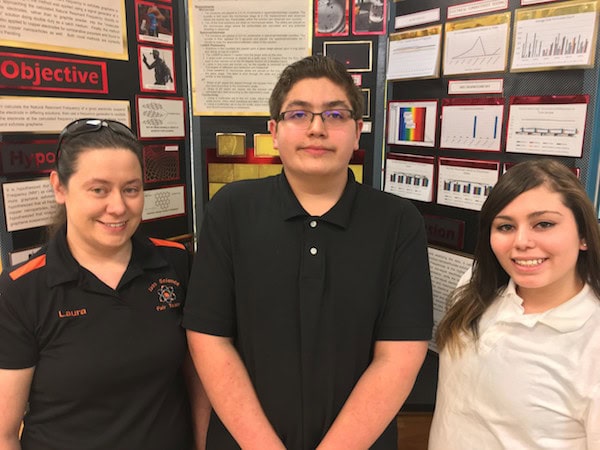
[Image above] (Left to right) Laura Tenorio, Taos Schools science fair director, and Taos High School students Indigo Acosta and Ariana Baca. Credit: Cody Hooks; The Taos News
It’s always exciting to hear about science students in the news.
High school student Indigo Acosta recently took first place in the senior division of materials science at the Northeastern New Mexico Regional Science Fair, held at New Mexico Highlands University in Las Vegas, N.M. He also earned a best in show for his project.
Inspired by the work of Nikola Tesla, Acosta, a ninth-grader at Taos High School in Taos, N.M., illustrated the use of resonant frequencies to shave a layer of graphene in his science project. In an article for The Taos News, Acosta said most industries “use heavy chemicals or radioactive materials” to make graphene.
Acosta’s experiment: Graphene exfoliation
Acosta suspended graphite electrodes in four different solutions—acetic acid, isopropyl alcohol, water, and isopropyl acetate—attached to a signal generator. Exposing each electrode to a calculated resonant frequency for 2.5 hours, he took samples every half hour from the suspension and examined them for the presence of graphene “using a spectrometer, pH, and particle examination via an inverted microscope,” Laura Tenorio, Taos Schools science fair director, wrote in an email.
Acosta compared his test solutions against commercially-prepared graphene samples for evidence of the material’s presence. “Graphene exfoliation is traditionally…a lengthy chemical and pressure-treated process that can be expensive and dangerous,” Tenorio added, “and is one of the primary reasons why graphene is very expensive to make.”
“This process that [Acosta] developed through research and experimentation takes less time, has less environmental impact, and is safer and cheaper than traditional exfoliation methods.”
Acosta continues his experiments to find a more accurate way to measure resonant frequency of test media and determine exact sizes and amounts of graphene produced by these methods, Tenorio says.
“Our students from the Taos ‘Tyger’ Lab are a group of students who believe that success is achieved through hard work and research—and that while we are part of a small town, our big dreams count too,” Tenorio says. “We do work on topics beyond the traditional science fair, as we focus more on scientific applications rather than the typical scientific method, and Indigo’s project is one major example of that.”
Tenorio and her students are excited for the next competition—the New Mexico State Science Fair, March 31–April 1.
Encouraging STEM education
A 2016 National Science Foundation report (pdf) found that the number of U.S. students who took an advanced placement exam in mathematics or science rose from 273,000 in 2003 to 527,000 in 2013. Even with these increases, just 17% of high school graduates took an advanced placement math or science exam, and only 10% passed.
The study also indicated that in 2009, 39% of ninth graders enrolled in biology. In 2012, 41% of these students, now in grade 11, were enrolled in another basic science course, chemistry, or physics.
However, compared to the rest of the world, the average science literacy score for U.S. students in 2012 was 497, lower than the average science literary score of 511 for all developed countries.
So we need to continue to encourage students who express interest in the sciences.
The Ceramic and Glass Industry Foundation is dedicated to developing talent in the ceramic and glass industry and offers a way for businesses to help that effort with its Materials Science Classroom Kits. Companies can purchase and donate kits to their local schools—it just might spark a student’s interest in pursuing science as a career.
“The fact that I get to think and experiment in a similar fashion to legends like Tesla and the discoverers of graphene is a boost towards encouraging me to stay in a STEM field, particularly materials sciences,” Acosta says.
Remember the name Indigo Acosta. You just might hear about him again someday.
Author
Faye Oney
CTT Categories
- Basic Science
- Education


